CLICK HERE for the latest market quotes from the Iowa Agribusiness Network!
CLICK HERE for the latest market quotes from the Brownfield Ag News Network!
CLICK HERE for the latest market quotes from the Iowa Agribusiness Network!
CLICK HERE for the latest market quotes from the Brownfield Ag News Network!
(Radio Iowa) – It’s common to see a jellyfish along a beach in a warm weather state, but it’s unusual to find one in an Iowa farm pond. That’s what D-N-R fisheries biologist John Lorenzen recently confirmed after hearing from a farmer in Guthrie County.
“What are the odds of jellyfish surviving in a pond in Iowa? And so my initial reaction was, it’s got to be something else. But they definitely were jellyfish,” Lorenzen says. He says the Peach Blossom Jellyfish, an animal native to China and are about the size of a nickel. D-N-R Aquatic Invasive Species Program Coordinator Kim Bogenschutz was intrigued by the discovery.
“Honestly I thought it was pretty cool,” she says. ” I think that these jellyfish are something that we just don’t know that much about. When I dug into the data, I did find two previous reports from quarries in Iowa.” Bogenschutz says the jellyfish do not pose any environmental concerns and, due to their tiny size, aren’t able to sting humans.
D-N-R officials say there are theories on how the jellyfish ended up in Iowa, including migrating birds, fish stocking, or someone dumping their aquarium, which is illegal.
(Council Bluffs, Iowa) – Officials with the Pottawattamie County Emergency Management Agency say a ban on open burning is in effect immediately for all areas and jurisdictions in Pottawatamie County. The ban prohibits all open and controlled burning in Pottawatamie County, including all incorporated city limits within the County.
The current dry conditions throughout the region have increased the potential for wildland fire incidents. As dry conditions persist, dead and dying vegetation is the perfect fuel to spread fires rapidly. This type of fire behavior is difficult to control and is extremely dangerous to responders and the public.
During these dry conditions, citizens are reminded to not throw out cigarettes from moving vehicles, and discontinue burning yard waste, piled tree debris or other items during the ban. Violations of a burn ban can subject a person to criminal penalties as well as civil liabilities for any damages, losses, or injuries resulting from the fire.
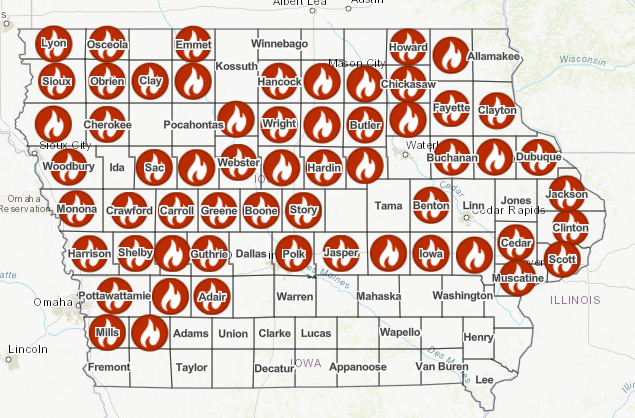
Iowa counties with Burn Bans in effect (as of 10-14-24)
Visit the Emergency Management website at www.pottcounty-ia.gov/emergency_management for more information on burn bans and the law. All residents are also encouraged to sign up for AlertIowa at the website to receive alerts for fire danger, evacuation notices, severe weather threats, and community emergency notifications.
There are now 58 out of Iowa’s 99 counties that are in a ban on open burning. With the addition of Pott. County, other area counties include: Cass, Adair, Audubon, Guthrie, Harrison, Mills, Montgomery, and Shelby.
JOHNSTON, Iowa – October 14, 2024 – Officials with Iowa Corn have announced the names of students selected to participate in the 2024-2025 school year’s Collegiate Advisory Team (CAT) program. The program focuses on increasing college students’ understanding of the corn industry. During the one-year program, students will visit the Capitol, tour industry leaders’ operations, and expand their network and knowledge outside of the classroom. 
2024 – 2025 Collegiate Advisory Team Students:
The Collegiate Advisory Team will meet four times over the course of the 2024 – 2025 school year, providing experience and training by Iowa Corn in areas such as leadership, effective communication, policy, and industry relations. For more information on the program, visit https://www.iowacorn.org/CAT
(Radio Iowa) – Iowa Congressman Randy Feenstra says the prospects for passage of a five-year Farm Bill are positive — after the election. “We have great hope that we can come together, that all four corners — meaning Republicans and Democrats in the House and Senate can come together and pass a Farm Bill,” Feenstra says. If no action is taken before the end of the year, the federal farm policies in place decades ago will go into effect — meaning farmers will not get federal crop insurance subsidies, for example. “We have been meeting over the last few months, trying to get this done,” Feenstra says. “We as House Republicans passed it bipartisanly out of the (House) Ag Committee. We could take it to the floor, but we don’t want to negotiate against ourselves.”
The Senate Ag Committee has not passed its own version of the Farm Bill and Democrats who are in the majority in the Senate say the House G-O-P’s proposed 30 BILLION dollar cut in federal food assistance is unacceptable. Feenstra, a Republican from Hull, says funding for the Supplemental Nutrition Assistance Program is a stumbling block. “SNAP is one of the challenges,” Feenstra says. “SNAP is the nutritional program that’s 85% of the cost of the Farm Bill. We want a responsible SNAP program. That’s very important.”
Ryan Melton of Webster City, the Democrat who’s running against Feenstra, says the Farm Bill needs to address water quality. “I certainly agree that we need to subsidize ag, but we have choice over how we do that,” Melton says. “I’ve talked to plenty of farmers on the ground that know — farmers themselves who know that the status quo is not working…that so many of folks cannot recreate in our rivers and lakes and our streams.” Melton says federal farm policy has to respond to the significant increase in large-scale livestock operations. “You’re adding so much more manure to the landscape and yet you have not added more and more mitigation strategies to protect our waterways,” Melton says. “We need to sinc up the increase with increased protections for public health and for water.”
Melton suggests it’s time to consider federal regulations on how much manure and other farm chemicals can be applied to cropland. “We need to be more responsible when we have a ramp up in industrial ag to also recognize the downstream implications, which are many,” Melton says, “to public health, to home values, to the hollowing out of our communities, to the fact that they are driving more and more small and mid-scale farmers off the land.”
Melton made his comments during a recent appearance on Iowa Press on Iowa P-B-S.
(Iowa News Service) – American agroforestry initiatives got a big boost of funding in 2022 from the U.S. Department of Agriculture (USDA), which allocated $60 million to help farmers transition toward this style of climate-friendlier farming, as part of the Partnership for Climate-Smart Commodities program. The Nature Conservancy (TNC) is leading the multi-partner effort, allocating money to farmers across 30 states. Dubbed the Expanding Agroforestry Project, it will provide technical assistance and funding to farmers for planting new agroforestry acres on their land. The goal is to plant 12,140 new hectares (30,000 acres) of agroforestry across the U.S.
Recently, Mongabay checked in to see how agroforestry efforts were progressing and whether funds were making their way to farmers. After the first application cycle, farmers in 21 states submitted more than 200 applications to the program, representing about 20% of the agroforestry acreage goals. Like agroforestry itself, the application, training and distribution of funds take some time to get off the ground — the first incentive payments are anticipated to be disbursed in the summer and fall of 2024.
Expanding Agroforestry Project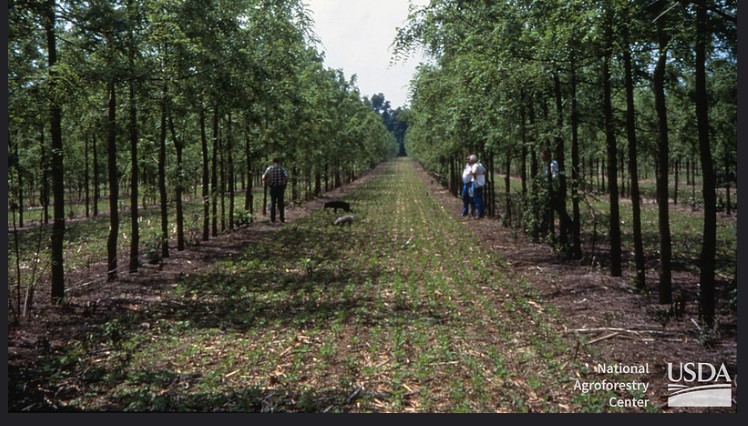
The Expanding Agroforestry Project is part of the USDA’s larger Partnerships for Climate-Smart Commodities program — a $3.1 billion effort to fund projects to fight climate change while supporting landowners. Agroforestry practices are effective at capturing carbon while providing additional commodities and land benefits to farmers. Above and below ground, agroforestry systems typically capture 2–5 metric tons of CO2 per acre per year. Nate Lawrence, ecosystem scientist for the Savanna Institute, expanded on the science of measuring such figures during a recent podcast.
As the lead administrator of the grant, TNC is “processing $36 million … in incentive payments directly to enrolled producers,” Audrey Epp Schmidt, the agroforestry program manager at The Nature Conservancy, explained in an email. The remaining $24 million will support the expansion of project partner organizations, including adding staff capacity for the agroforestry work. These funds will also bolster measurement, monitoring, reporting and verification activities and develop market opportunities for agroforestry commodities, she said. With the influx of federal funding, TNC created a five-year program to provide growers with technical help and funding to support agroforestry efforts. To get the word out, the project partners launched a communication effort that included emails, social media posts and virtual presentations, along with in-person events on farms.
“Producers typically want to hear directly from other producers, so we encourage farmer-to-farmer networks to help drive adoption whenever possible,” Epp Schmidt said. TNC’s goal is to attract at least 200 farmers to the program, with at least 50 of those being underserved producers, said Epp Schmidt. The USDA defines underserved producers as farmers who are new, have limited financial resources, are socially disadvantaged (either by race or gender) or are military veterans. Epp Schmidt said the program includes the adoption of alley cropping, silvopasture and windbreak projects.
Alley cropping means planting rows of trees or shrubs within crops, while windbreaks are planted on the edges of fields (stopping or slowing wind erosion while adding biodiversity). Silvopasture is an agroforestry practice that integrates trees, pasture, forage plants and livestock into a single system. She noted the program is focused on adding new fruit, nut, timber and biodiversity-supporting trees that are ecologically suitable for the project site. Agroforestry enhances biodiversity on farms by breaking up large expanses of the same crop, called monocropping. By planting trees, shrubs and understory plants, farmers can attract beneficial insects, fungi and wildlife to their land, bolstering pollinators and potentially reducing the need for insecticides.
After being accepted to the program, farmers are matched with a technical assistance staff member — each region has its own partner organization — to support developing an agroforestry plan for the farmers’ land. The program subsidizes the cost of tree planting, providing $36 million in incentive payments directly to producers. Wendy Johnson, a farmer at Jóia Food & Fiber Farm and active agroforestry practitioner in Iowa, said she heard about the program in its early stages and thought it was an important step forward for agroforestry support. Johnson, who has planted more than 6,000 trees on her farm, is not able to apply for funding from the project — her trees are already in the ground. But she said learning about the program was “really exciting because it’s finally providing a dollar amount that would help with maintenance costs, too.”
She knows that young trees need a lot of care in the early years before they are fully established. “Maintenance is huge, and I can’t stress that enough,” she said. “You can’t just plant a tree and let it go — it also needs shelter and it needs care for the first three years … otherwise that investment is lost.” Johnson noted that on her own farm, the planted saplings coincided with record drought — and regular watering of the seedlings is a time- and labor-intensive endeavor. Such issues are only likely to amplify due to the worsening impacts of climate change. Committing to years of maintenance and switching part of a farm to more diversified land use may take a leap of faith. It can also mean farmers have to accept a risk to their profitability, often lasting for years.
“These are complex, perennial systems, and that involves a temporal mindset,” said John Munsell, forest management extension specialist at Virginia Tech. He added that an adaptive management plan will help farmers adjust in the eight-plus years between planting and maturity of trees and shrubs. Munsell said that a program like Expanding Agroforestry can get farmers to take a chance on planting. “This will tip the scale for many,” he said. And while farmers wait for their plantings to mature, Munsell said the agroforestry community can strengthen the market for forest products. “While your hazelnuts are maturing … you have eight years to move into a market space and set things up.”
Launching the program
The initial application cycle of the Expanding Agroforestry Project received 213 applications from producers in 21 states for the incentive payment program, noted Epp Schmidt. Of these, 93% self-reported as underserved farmers. She said these farmers potentially represent more than “6,300 acres of new agroforestry plantings.” Farmers who are interested in the program can learn more on TNC’s website. There are two application cycles each year, and the next deadline will be in late summer.
(Radio Iowa) – Weather conditions are ideal for harvest and Iowa farmers are able to move at a quick pace this year. Andy Sabers farms north of Manchester and says it’s not often they’re blessed with day after day of sunshine and warm temperatures during fall.
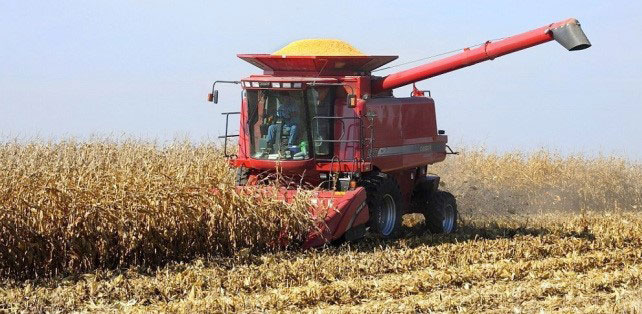
Combine harvesting corn. (ISU Extension photo)
Alan Atwater farms southwest of Manchester and says the harvest work has pretty much been non-stop since they started.
The latest U-S-D-A crop report shows 22-percent of the state’s corn has been harvested, a day ahead of normal, while the soybean harvest has reached 58-percent complete, one week ahead of average. Cooler temperatures are in the forecast, and dry weather is expected to continue into next week.
(Atlantic, IA – by FFA Reporter Maddy Anderson) – Each year the Southwest FFA District and Iowa FFA officers plan and facilitate Greenhand Fire Up Conferences for FFA members in the Southwest District. Atlantic High School welcomed 375 FFA members from 29 FFA chapters from all over the Southwest District on Wednesday October 9th.
While at Atlantic High School on Wednesday, district and state officers lead four interactive workshops for first year high school FFA members, also known as Greenhands, for the annual Greenhand Fire Up Conference. The workshops facilitated were leadership focused with an emphasis on the experiences that occur in the lives of beginning high school students.
Iowa FFA President, Collin Bauer, stated, “Greenhand Fire Up provides a chance for first-year high school members to get a sneak peek of the opportunities that FFA holds, and is a conference for members to meet and interact with state and district officers.”
This year 11 Atlantic FFA members participated in Greenhand Fire Up Camp. Rylan Martin said, “I had a great time at Greenhand Fire Up Camp. It was a good experience and I had a lot of fun meeting new people.“ Clara Kennedy said, “I had a lot of fun and I think that every 8th and 9th grade FFA member should go to this conference.”
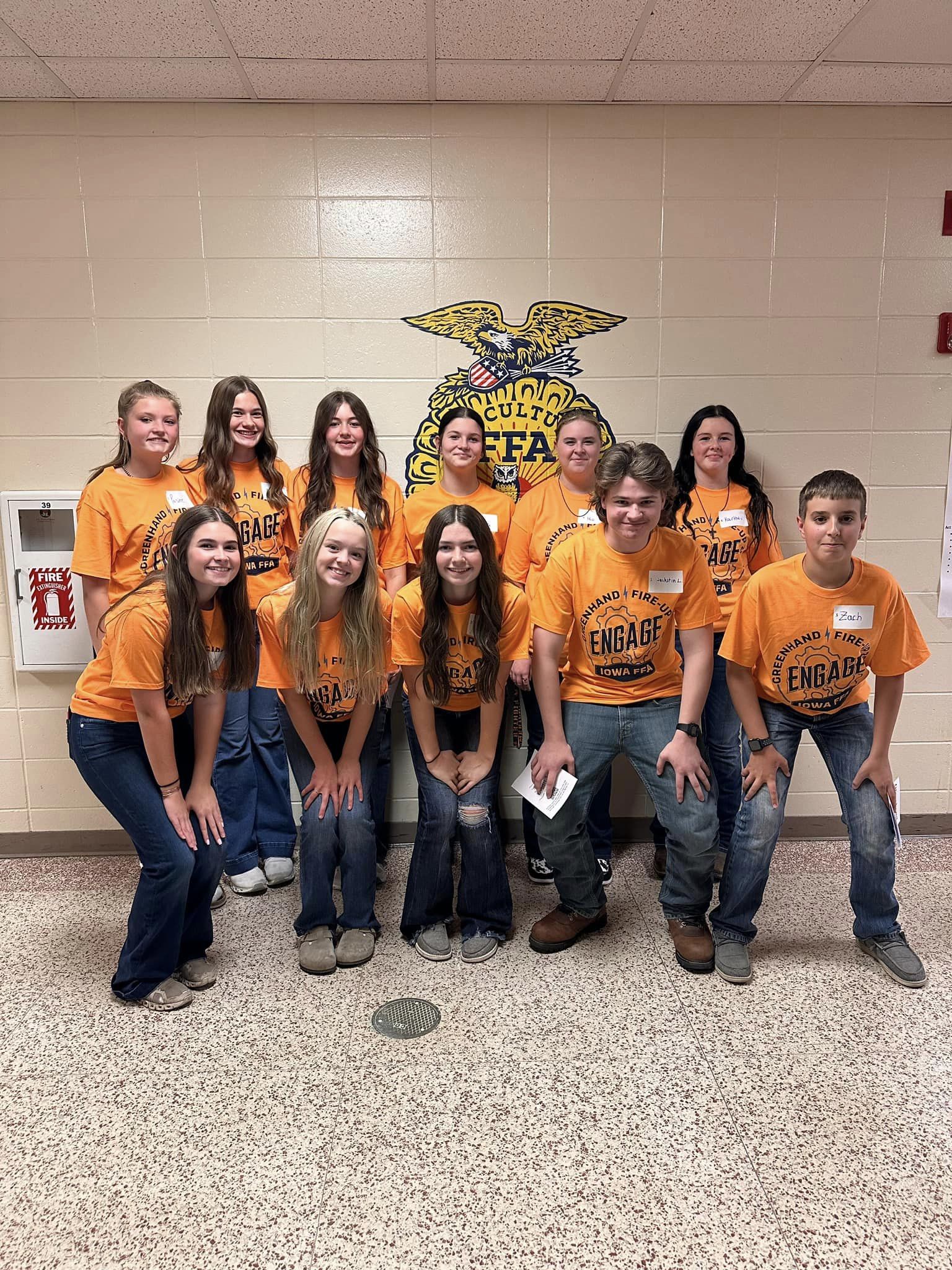
left to right
Front row
Chloe Sonntag, Jovie Richter, Dylin Ball, Jackstin Lucas, Zack Boes
Back Row
Paislee Klever, Clara Kennedy, Rylan Martin, Ciara Tasto, Mia Kloewer, Kourtney Ross
The officers prepared and facilitated workshops of: authenticity, balancing priorities, communication, and FFA opportunities – in order to provide the first-year FFA members with skills they would use both within and outside of FFA. The goal was to engage FFA members in learning about the tools that would allow them to be successful in anything they are part of through high school and beyond.
Greenhand Fire Up is made possible with support from the Iowa FFA Foundation.
(Marysville, M).) – Atlantic FFA Reporter Maddy Anderson reports that on October 3rd (2024), 27 Atlantic FFA members attended the fall contest held at Northwest Missouri State University located in Maryville, Missouri. The members got the opportunity to compete in several different contests. The Floriculture Team had 5 members compete placing 1st in the Iowa Division and 5th Overall.

Floriculture Team Left to Right:
Rylan Martin, Jacquie Freund, Journey Saffron, Paislee Klever, Nataile Smith
Team members Rylan Martin placed 11th, Jacquie Freund placed 13th, Journey Saffron 27th, Paislee Klever 41st and Nataile Smith placed 70th. The Floriculture CDE includes three phases: Identification of Plant Materials, Identification of Greenhouse/Floriculture Tools & Supplies, Disorders and Diagnosis, and a General Knowledge Examination. Jacquie Freund said “ It was a fun new experience and I loved meeting new friends and looking at all the pretty flowers.
This year, the chapter had 5 members compete in the Livestock Evaluation contest, placing 4th out in the Iowa Division and 9th overall. The scores from Atlantic FFA Miraylie Stuart 22nd, Addalyn Sonntag 51st, Aly Dreager 65th, Maddy Anderson 76 and Tenley Cappel 108th out of more than 170 contestants. Addalyn Sonntag said “ I felt like it was a great day to do some livestock judging, and I enjoy learning more about judging and getting better at it.” In this contest, members had the opportunity to display their agricultural knowledge of various livestock breeds. Those who competed had to place breeding and market classes of beef, swine, and sheep, while also doing three classes of oral reasons.
The Horse Judging Contest had Atlantic FFA members place 3rd in the Iowa Division and 5th Overall. Team members Kayedance Sturm placed 9th, Callie Rudy placed 15th and Clara Kennedy placed 26th overall. The Horse judging contest consisted of a 25 question written exam, 3 halter classes, 1 performance class and two sets of oral reasons.
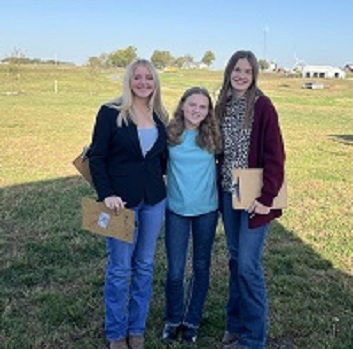
Horse Judging Team
Left to Right:
Kayedance Sturm, Callie Rudy and Clara Kennedy
The Dairy Foods contest had 7 members compete in the contest placing 2nd in the Iowa Division and 11t overall. The team was made up of Lola Comes 20th, Dani Bennett 55th, Hayden Kleen 66th, Keston Schmitt 81st, Hunter Quist 96th, Braden Wood 98, and Frank Freund 101st. This contest has members try different types of cheese, find the defects in milk, look at milking equipment, and take a written exam. Together they placed as the top Iowa team. Hunter Quist said “ I had a great time eating dairy foods like cheese and drinking milk,Also I disliked the written test.”
In the FFA Knowledge Exam Atlantic FFA placed 2nd in the Iowa Division and 10th overall. Members Lily Johnson placed 7th, Lauren Comes placed 23rd and Mia Kloewer placed 140th overall. This contest consisted of a 100 question written examination covering general FFA knowledge. Lauren Comes: “I enjoy going to the northwest to try a new contest that I haven’t done before.” In the Dairy Cattle Evaluation contest, Dylen Dreager and David Retallic competed in this contest. Dyle placed 24th and David placed 104th even though he did not have time to complete the entire contest. The purpose of the District Dairy Cattle CDE is to enable students to develop skills in dairy animal selection and dairy herd management. They evaluated and ranked dairy animals based on visual factors of selection.
Finally, in the Farm Business Management exam Atlantic FFA member Jarrett Hansen placed 32nd out of 106 individuals. The Farm Management CDE consisted of an objective test over management principles, record analysis, marketing, budgeting, and farm business organization. Jarrett Hansen said “ It was a really fun time going to a different state to compete with kids I never met.”
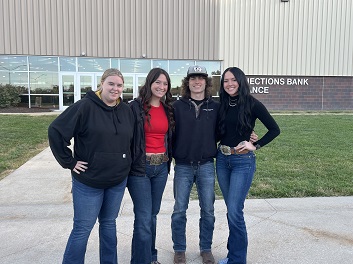
FFA Knowledge and Farm Business Exam
Left to Right:
Mia Kloewer, Lily Johnson, Jarrett Hansen, Lauren Comes
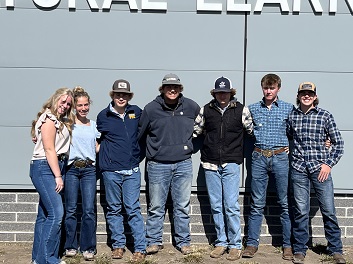
Dairy Foods Left to Right: Dani Bennett, Lola Comes, Braden Wood, Hayden Kleen, Keston Schmitt, Frank Freund and Hunter Quist
(Radio Iowa) – After last month turned out to be Iowa’s driest September on record, October’s shaping up to be just as dry and the drought conditions are worsening. The new map from the U.S. Drought Monitor shows the patches of severe drought are growing in both western Iowa and in the northeast, now covering more than seven percent of the state. A much larger section, 49-percent, is considered in moderate drought, and that stretches across the majority of Iowa’s northern half and much of the west. About 41-percent of the state is considered abnormally dry, while only about two-and-a-half percent has no moisture worries — at the moment at least — across a few counties in the southwest.
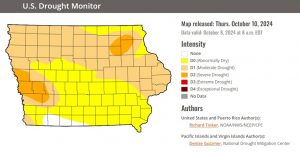
Graphic from the U.S. Drought Monitor
Forecasters say a cold front should start to arrive tonight (Friday) that will bring progressively colder temperatures over the next several days, with the first frost likely for Iowa next Tuesday. There are little to no chances for rain for at least another week.
Cass County Farm Bureau & East Pottawattamie County are recognizing Pork Month this October.
Livestock plays a vital role in the local economy, accounting for 11% of jobs in both Cass County and Pottawattamie County. Jobs that support pig farmers like trucking, animal nutrition and veterinary services strengthen communities and contribute to economic growth.
Thanks to cutting-edge research, farmer-led changes and advancements in technology, today’s pork is more sustainable and nutritious than ever before. Since the 1990s, U.S. pork production has increased by an impressive 76% while emissions per pound of pork have decreased by 23%.
Not only is pork sustainably raised, it remains a staple of a healthy diet.
Pork is an excellent source of nutrients and vitamins that regulate metabolism, strengthen bones, promote energy and aid in red blood cell formation. Health-conscious consumers can enjoy pork tenderloin and pork sirloin roast, both of which meet the American Heart Association’s Heart-Check certification for containing low levels of fat, saturated fat and sodium.
To learn more about how farmers raise pigs, follow the Cass County Farm Bureau & East Pottawattamie County on Facebook.